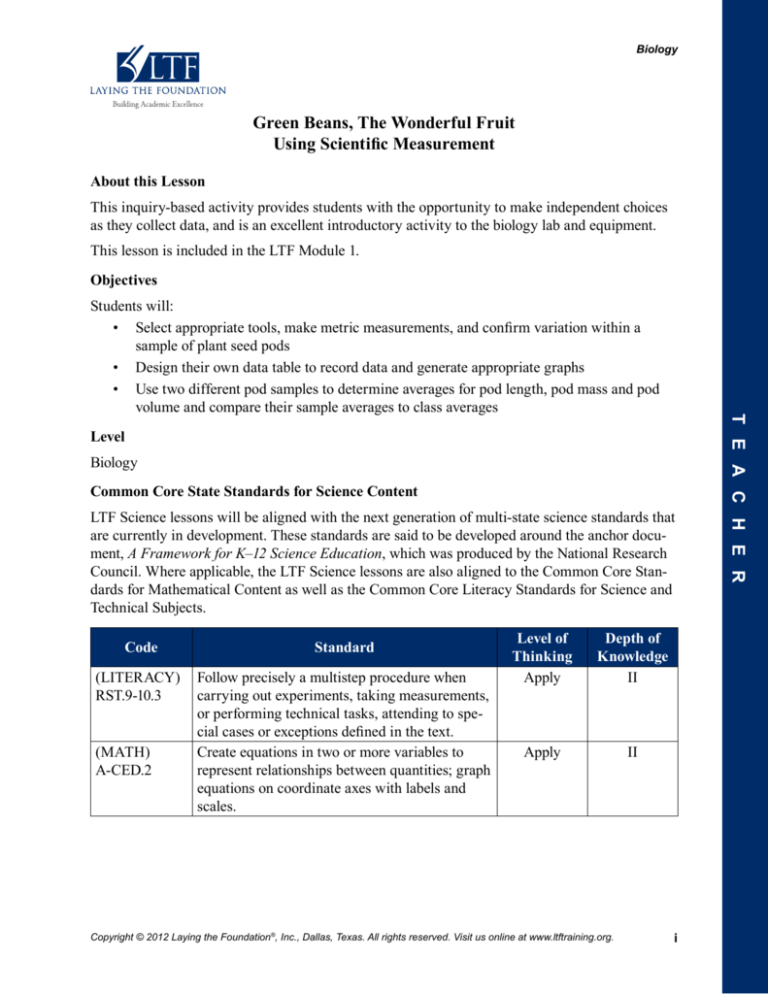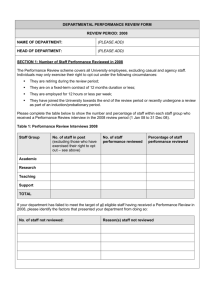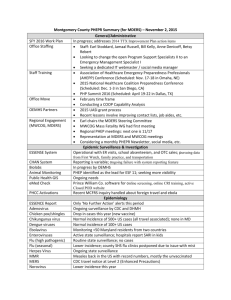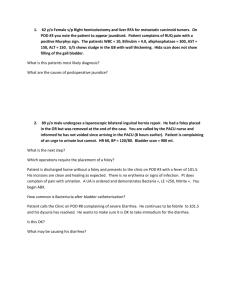
Biology
Green Beans, The Wonderful Fruit
Using Scientific Measurement
About this Lesson
This inquiry-based activity provides students with the opportunity to make independent choices
as they collect data, and is an excellent introductory activity to the biology lab and equipment.
This lesson is included in the LTF Module 1.
Objectives
Level
Biology
Common Core State Standards for Science Content
LTF Science lessons will be aligned with the next generation of multi-state science standards that
are currently in development. These standards are said to be developed around the anchor document, A Framework for K–12 Science Education, which was produced by the National Research
Council. Where applicable, the LTF Science lessons are also aligned to the Common Core Standards for Mathematical Content as well as the Common Core Literacy Standards for Science and
Technical Subjects.
Code
Standard
(LITERACY)
RST.9-10.3
Follow precisely a multistep procedure when
carrying out experiments, taking measurements,
or performing technical tasks, attending to special cases or exceptions defined in the text.
Create equations in two or more variables to
represent relationships between quantities; graph
equations on coordinate axes with labels and
scales.
(MATH)
A-CED.2
Level of
Thinking
Apply
Depth of
Knowledge
II
Apply
II
Copyright © 2012 Laying the Foundation®, Inc., Dallas, Texas. All rights reserved. Visit us online at www.ltftraining.org.
i
T E A C H E R
Students will:
• Select appropriate tools, make metric measurements, and confirm variation within a
sample of plant seed pods
• Design their own data table to record data and generate appropriate graphs
• Use two different pod samples to determine averages for pod length, pod mass and pod
volume and compare their sample averages to class averages
Teacher Overview – Green Beans, The Wonderful Fruit
Connections to AP*
AP Biology: This lesson addresses concepts contained in Big Idea 1 and 4 in the revised AP
Biology curriculum under the following sections: 1.A.2.d and 4.C.2.a.
*Advanced Placement and AP are registered trademarks of the College Entrance Examination Board. The College
Board was not involved in the production of this product.
Materials and Resources
Each lab group will need the following:
balance
beaker, 250 mL
beaker, 600 mL
calculator
graduated cylinder, 100 mL
graduated cylinder, 50 mL
graduated cylinder, 500 mL
paper towels
ruler, clear metric
string, approx. 20 cm
6 green beans
6 snow pea pods
Assessments
T E A C H E R
The following types of formative assessments are embedded in this lesson:
• Visual assessment of selection of equipment and measuring techniques used within the
lesson
• Sharing class data
The following assessments are located on the LTF website:
• Short Lesson Assessment: Green Beans, the Wonderful Fruit
• Nature of Science Assessment
Teaching Suggestions
Students are expected to make many independent choices as they collect the data for this activity.
To start, they must select the appropriate measurement tools. You should put out a variety of
linear measurement tools and volume measurement tools from which they must choose.
Encourage students to share data with other groups to increase their sample size and validity.
Some students may have difficulty coming up with the volume displacement method. Ask
leading questions rather than telling them the correct procedure. Hopefully, after determining
the volume for a couple of pods using this laboratory skill students will work together to find a
faster method. At this point, they may ask for a larger graduated cylinder so they can measure the
entire sample for displacement and then divide by the number of pods. Have several beakers and
graduated cylinders of varying sizes ready, and be sure to remind them of the low level of accuracy achieved by measuring volume using the graduations on the outside of the beaker. They will
probably apply the “whole sample” procedure when determining the average mass.
You will have to continually press students to write down the steps used in their procedure but
this is excellent practice for writing free response essays in which they will be expected to detail
procedures.
Copyright © 2012 Laying the Foundation®, Inc., Dallas, Texas. All rights reserved. Visit us online at www.ltftraining.org.
ii
Teacher Overview – Green Beans, The Wonderful Fruit
This activity requires students to prepare four data tables. Often students have been given a prelabeled data table and may struggle with how to arrange their data into a useful format. You will
want to discuss the attributes of a quality data table prior to this activity. Avoid the temptation
of setting up the data table for students. Have scratch paper handy for them to use in planning
the format of their table. This will be particularly necessary as they modify their procedures
to reflect “whole sample” data collection. Emphasize that if using the “whole sample” method,
their data table must still include their initial and final measurements and not just the averages.
Additionally, emphasize the importance of differentiating between what is measured and what is
calculated. For instance, initial and final volumes are measurements whereas net volume is not
measured but instead calculated.
Students must think through the design of the graphs in this activity. A review of independent
and dependent variables may be necessary. Students are asked to take data from two of their
tables and create graphs.
Snow peas make a good choice for a second type of seed pod. The produce and frozen foods
sections of the grocery store should provide sources of whole seed pods. You may prefer to have
students measure two different types of seeds rather than pods. For example, you could substitute
pinto beans and black-eyed peas for the pods.
Project Table A as shown for groups to record their averages.
Green
Bean
Snow
Pea
Green
Bean
Snow
Pea
T E A C H E R
Group
Number
Table A: Green Bean Data
Average Pod Length
Average Pod Mass
Average Pod Volume
Green
Bean
Snow
Pea
Class
Averages
v. 2.0, 2.0
Copyright © 2012 Laying the Foundation®, Inc., Dallas, Texas. All rights reserved. Visit us online at www.ltftraining.org.
iii
Teacher Overview – Green Beans, The Wonderful Fruit
Answer Key
Data and Observations
Table 1: Length of Green Bean Pods
Bean Pod
Length (cm)
1
13.2
2
14.1
3
13.7
4
15.8
5
13.6
6
16.5
Average bean pod length
13.5
Class average bean pod length
14.2
Copyright © 2012 Laying the Foundation®, Inc., Dallas, Texas. All rights reserved. Visit us online at www.ltftraining.org.
T E A C H E R
Table 2: Length of Snow Pea Pods
Pea Pod
Length (cm)
1
8.0
2
7.5
3
9.1
4
8.8
5
7.9
6
9.3
Average pea pod length
8.4
Class average pea pod length
8.2
iv
Teacher Overview – Green Beans, The Wonderful Fruit
Answer Key (continued)
Table 3: Average Green Bean Pod and Snow Pea Pod Mass
Pod Comparison
Green Beans (g)
Snow Peas (g)
Mass of all pods
15.6
14.3
Average mass of single pod (total mass
divided by number of pods)
Class average pod mass
2.6
2.3
2.7
2.1
Table 4: Average Green Bean Pod and Snow Pea Pod Volume
Pod Comparison
Green Beans (mL)
Snow Peas (mL)
Amount of water displaced by all pods
33.2
28.6
5.5
4.8
5.8
4.6
T E A C H E R
Average pod volume (water displaced
divided by number of pods)
Class average pod volume
Analysis
1. Students should report the range of shortest to longest pods. Discuss if the students counted
the stems or not.
2. Students should report the range of shortest to longest pod. Discuss if the students counted
the tip of the pod or not.
3. Answers will vary but most groups will not exactly match the class average because their
sample size is small.
4. Students should use numbers to show how their sample compares to the class average.
Discuss if students packed down the peas to get a more accurate volume or not.
5. Students should use numbers to show how their sample compares to the class average.
Steps Used to Determine Volume of Green Bean Pods
Answers will vary.
Graph 1 and Graph 2 will vary with bean and pea samples but should be comparative bar graphs.
Included here are samples of what student graphs might look like.
Graphs should contain all necessary elements: title, axis labels, legends, and units.
Copyright © 2012 Laying the Foundation®, Inc., Dallas, Texas. All rights reserved. Visit us online at www.ltftraining.org.
v
Teacher Overview – Green Beans, The Wonderful Fruit
Answer Key (continued)
Graph 1: Average Pod Mass
6
5
Mass (g)
4
Green beans
Snow peas
3
2
1
0
Pod Type
T E A C H E R
Graph 2: Average Pod Volume
6
Volume (mL)
5
4
Green beans
Snow peas
3
2
1
0
Pod Type
Conclusion Questions
1. Answers will vary. Students should include specific data when answering.
2. Green bean. A length of 11.5 cm (115 mm) is closer to the class average for green bean pods
than for snow pea pods.
3. Answer should be equal to the class average. The class average is more representative of the
typical green bean pod length.
Copyright © 2012 Laying the Foundation®, Inc., Dallas, Texas. All rights reserved. Visit us online at www.ltftraining.org.
vi
Biology
Green Beans, The Wonderful Fruit
Using Scientific Measurement
Darwin’s theory of natural selection included the observation that individuals in a population of
any species vary in many inheritable traits. Darwin realized that this variation is what makes
natural selection possible. Offspring will resemble, but not be identical to, each other and their
parents.
The variation found among species members may provide some members with a slight advantage. This advantage can lead to an increase in that variant within the population. Some of the
variation within a species is measurable. For example, one tree may be slightly taller at maturity than its sibling. One dog may be milliseconds faster than its litter mate. This small speed
advantage may make the dog able to catch the rabbit first, avoid starvation, and thereby live
long enough to reproduce. Variation is essential to the survival of a species in an ever-changing
ecosystem.
Purpose
In this activity, you will work with a partner to select the appropriate tools to make metric measurements. You will collect the data needed to determine the averages for pod length, pod mass,
and pod volume of two different species of plant pods. You will then design your own data table,
record the data, and generate appropriate graphs for communicating the data.
Materials
Each lab group will need the following:
balance
beaker, 250 mL
beaker, 600 mL
calculator
graduated cylinder, 100 mL
graduated cylinder, 50 mL
graduated cylinder, 500 mL
paper towels
ruler, clear metric
string, approx. 20 cm
6 green beans
6 snow pea pods
SAFETY ALERT!
» Do not eat or drink in the laboratory.
Copyright © 2012 Laying the Foundation®, Inc., Dallas, Texas. All rights reserved. Visit us online at www.ltftraining.org.
1
Student Activity – Green Beans, The Wonderful Fruit
Procedure
Part I: Variations in Pod Length
1. Design a data table in the space labeled Table 1 on your student answer page. Your table
should include places to record the length of six green bean pods, the average length of green
bean pods in your sample, and the class average green bean pod length.
2. Obtain six green bean pods and select the tools that you will use to measure the pods’ length.
3. Measure the length of the pods and record this data in Table 1.
4. Determine the average pod length for your sample and record this value in Table 1.
5. Share your average with the other groups in the class as your teacher instructs.
6. Design a data table in the space labeled Table 2 on your student answer page. Your table
should include places to record the length of six snow pea pods, the average length of snow
pea pods in your sample, and the class average snow pea pod length.
7. Obtain six snow pea pods and select the tools that you will use to measure the pods’ length.
8. Measure the length of the pods and record this data in Table 2.
9. Determine the average pod length for your sample and record this value in Table 2.
10. Share your average with the other groups in the class as your teacher instructs.
Part II: Variations in Pod Mass
1. Design a data table in the space labeled Table 3 in which you will record the average
pod mass based on your green bean sample, the average pod mass based on your snow
pea sample, and the class pod average for both types. Your data table should contain any
measurements taken as you determine the average pod mass for each type of pods.
2. Collect the mass data and record it in Table 3.
3. Share your average green bean pod and snow pea pod masses with the class as your teacher
instructs.
4. In the space marked Graph 1 on your student answer page, construct a graph of the data
found in Table 3. Be sure to include all of the appropriate parts of a graph.
Copyright © 2012 Laying the Foundation®, Inc., Dallas, Texas. All rights reserved. Visit us online at www.ltftraining.org.
2
Student Activity – Green Beans, The Wonderful Fruit
Procedure (continued)
Part III: Variations in Pod Volume
1. Devise a method for determining the volume of each of your green bean pods. Record the
steps you will follow in the space provided on your student answer page.
2. Design a data table in the space labeled Table 4 on the student answer page. Your table
should include places to record the volume of six snow pea pods and six green bean pods, the
average volume of snow pea pods in your sample and the average volume of green bean pods
in your sample, and the class average snow pea pod volume and green bean pod volume.
3. Collect the volume data and record it in Table 4.
4. Share your average green bean pod and snow pea pod volumes with the class as your teacher
instructs.
5. In the space marked Graph 2 on your student answer page, construct a graph of the data
found in Table 4. Be sure to include all of the appropriate parts of a graph.
Copyright © 2012 Laying the Foundation®, Inc., Dallas, Texas. All rights reserved. Visit us online at www.ltftraining.org.
3
Student Activity – Green Beans, The Wonderful Fruit
Data and Observations
Table 1: Length of Green Bean Pods
Table 2: Length of Snow Pea Pods
Copyright © 2012 Laying the Foundation®, Inc., Dallas, Texas. All rights reserved. Visit us online at www.ltftraining.org.
4
Student Activity – Green Beans, The Wonderful Fruit
Data and Observations (continued)
Table 3: Average Green Bean Pod and Snow Pea Pod Mass
Table 4: Average Green Bean Pod and Snow Pea Pod Volume
Copyright © 2012 Laying the Foundation®, Inc., Dallas, Texas. All rights reserved. Visit us online at www.ltftraining.org.
5
Student Activity – Green Beans, The Wonderful Fruit
Analysis
Steps Used to Determine Volume of Green Bean Pods
Copyright © 2012 Laying the Foundation®, Inc., Dallas, Texas. All rights reserved. Visit us online at www.ltftraining.org.
6
Student Activity – Green Beans, The Wonderful Fruit
Analysis (continued)
1. What is the range of length variation for the green bean pods in your sample?
2. What is the range of length variation for the snow pea pods in your sample?
3. Is your green bean pod length average the same as the class average? Explain the reason for
your answer.
4. How much variation is there when you compare the average pod volumes in your green bean
and snow pea samples to that of the class?
5. How much variation is there when you compare the average pod masses in your green bean
and snow pea samples to that of the class?
Copyright © 2012 Laying the Foundation®, Inc., Dallas, Texas. All rights reserved. Visit us online at www.ltftraining.org.
7
Student Activity – Green Beans, The Wonderful Fruit
Analysis (continued)
Graph 1: _________________________________________ (title)
Graph 2: _________________________________________ (title)
Copyright © 2012 Laying the Foundation®, Inc., Dallas, Texas. All rights reserved. Visit us online at www.ltftraining.org.
8
Student Activity – Green Beans, The Wonderful Fruit
Conclusion Questions
1. Does your green bean sample show variation in mass, length, and volume? Support your
answer with data.
2. If you were told that an unidentified bean was 115 mm long, would you predict that this bean
is most likely a green bean or a snow pea? Explain.
3. If you were randomly given a green bean of the same variety used in this activity, what would
you predict its mass to be? Explain.
Copyright © 2012 Laying the Foundation®, Inc., Dallas, Texas. All rights reserved. Visit us online at www.ltftraining.org.
9






![Domiciliary Care leaflet editted_new.doc[...]](http://s3.studylib.net/store/data/007119587_1-e85760c65789a5d1ecb4c83918ba0905-300x300.png)



